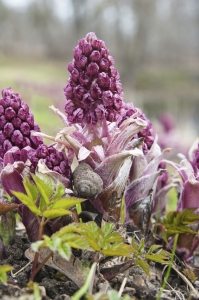 Butterbur (Petasites hybridus), a member of the daisy family, grows in wet areas, such as marshes, and along rivers in parts of North America and in northern Asia and Europe. It has reddish flowers in the spring, before producing large heart-shaped leaves that resemble small umbrellas. Some say it has an unpleasant smell.
Butterbur (Petasites hybridus), a member of the daisy family, grows in wet areas, such as marshes, and along rivers in parts of North America and in northern Asia and Europe. It has reddish flowers in the spring, before producing large heart-shaped leaves that resemble small umbrellas. Some say it has an unpleasant smell.
Butterbur has a variety of medicinal purposes. It contains several different active compounds, including flavonoids, tannins, petasin, and isopetasin, that are believed to give it healthful benefits.
How can it help?
Although more research is needed, butterbur may benefit people with allergies by decreasing the production of leukotrienes and histamine. These two substances in the body cause allergy symptoms.
The herbal extract has also been used to treat asthma, hay fever, whooping cough, irritable bladder, insomnia, anxiety, fevers, chills, and stomach cramps. It can also stimulate the appetite. Externally, it has been applied to heal wounds and skin ulcerations.
The herbal extract has also been used to treat asthma, hay fever, whooping cough, irritable bladder, insomnia, anxiety, fevers, chills, and stomach cramps. It can also stimulate the appetite. Externally, it has been applied to heal wounds and skin ulcerations.
But perhaps it is most well known to prevent migraine headaches. Petasin, one of its active compounds, is an anti-inflammatory and muscle relaxant. Taken as a nutritional supplement, butterbur can also help control irritable blood vessels, which might cause migraines.
Clinical studies performed in Germany have confirmed that butterbur may decrease the frequency of migraine headaches by up to 50 percent in long-term migraine sufferers.1-4
Taking butterbur
Be cautious when taking butterbur. Don’t take any products that contain pyrrolizidine alkaloids (PAs), which are liver-toxic and possibly contain carcinogenic components.
Take butterbur medicinally as a nutritional supplement pill, an alcohol-based tincture, or as an herbal tea. The latter two may be undesirable due to the bitter taste, however. As a tablet or capsule, butterbur will dissolve in the stomach—avoiding any unpalatable taste.
A typical dosage of butterbur to prevent migraines is 50 to 75 milligrams twice a day.
References
1 Lipton RB, Gobel H, Einhaupl KM, Wilks K, Mauskop A. Petasites hybridus root (butterbur) is an effective preventive treatment for migraine. Neurology. 2004 Dec 28;63(12):2240-4.
2 Grossmann M, Schmidramsl H. An extract of Petasites hybridus is effective in the prophylaxis of migraine. Int J Clin Pharmacol Ther. 2000 Sep;38(9):430-5.
3 Diener HC, Rahlfs VW, Danesch U. The first placebo-controlled trial of a special butterbur root extract for the prevention of migraine: reanalysis of efficacy criteria. Eur Neurol. 2004;51(2):89-97.
4 Pothmann R, Danesch U. Migraine prevention in children and adolescents: results of an open study with a special butterbur root extract. Headache. 2005 Mar;45(3):196-203.





